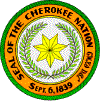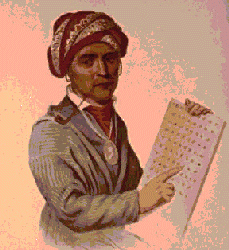My father's maternal great grandmother was a full blood Cherokee, probably from Tennessee, who died in Arkansas. She may have been born before or after the forced removal of the Cherokee Nation from their homelands in North Carolina, Tennessee and Georgia to the reservations of Arkansas and Oklahoma during the period of 1838-39, but that has not been confirmed. The dates of her birth and death are unknown but it is logical that she was born before 1860, and that she died after 1878.
I know this is true because my great grandmother, Katie Emily Grant Pierce was born in Arkansas in 1878, so assuming that my great great grandmother was at least 18 years old when my great grandmother was born she would have had to be born during or before 1860, and as my great grandmother was born in 1878, my great great grandmother would have had to have lived at least that long. I wish I knew a lot more about her, but all of the people in our family who knew her personally are now deceased, taking with them facts that are now lost, probably forever. Such is the dilemma of the times in early America, continuing to today, unfortunately, when people just don't bother to record family history and preserve it for future generations. One of the major purposes of this web site is to provide a limited knowledge of our family for future generations. Hopefully, they will see the importance of passing on the family legacy to their progeny.

Four generations later, my dad still exhibited many of the distinct characteristics of the Cherokee and Apache blood he carried in his veins. The high cheekbones, bent nose, reddish brown skin tone, course, dark hair and other physical traits, along with a no-nonsense attitude, showed the Native American blood coursing through his veins. That blood carried the Cherokee and Apache pride. And, he honored that blood, never denying his heritage like many did, but rather celebrating it even though he knew less about the precise details of his ancestry than I know today, thanks to the modern conveniences of computers linked together around the world. We were always told of our Native American lineage. but most of the detail was either never told to us or long ago forgotten - either is a possibility considering that I survived the mid 60's through the mid 70's as a rock 'n roll musician and all my ancestors with any knowledge of such things have long ago passed to the other side.

Click the logo above to visit the Official Web Site of the Cherokee Nation.
The Cherokee are a descendant faction of the Iroquois who lived in the areas of upstate New York and southeastern Canada. The Cherokee Nation has its roots in the area around Tennessee, North and South Carolina and Georgia where it flourished for well over one thousand years. It was a democratic society consisting of seven tribes known as Bird, Paint, Deer, Wolf, Blue, Long Hair and Wild Potato, each of which chose its own representatives to sit in council with other representatives of the Cherokee Nation. Tribes were run by women who chose the Peace Chief and the War Chief. The Peace Chief was leader of the tribe during times of peace while the War Chief was the military leader in conflicts with other Native American Nations or foreign adversaries. But, the chiefs did not rule absolutely, instead being the leaders of a democratic society in which every tribal member had a say in the affairs of the tribe. Usually, the chiefs were older men who served until death, infirmity or corruption forced their replacement.
Earliest contact with Europeans came in the 1500's. As much as the Cherokee learned from their European visitors they were much more advanced in political and governmental matters and even taught much about democracy to those early European contacts. The bicultural government and society of the Cherokee Nation was equal to the most civilized nations of that time.
 Unlike migratory tribes of the plains, the Cherokee lived in permanent housing, moving only when necessitated by soil fatigue, natural disasters or other causes that prompted their relocation. They lived in long houses, in a communal setting, and never married within their own clan so as to keep the bloodline healty and fresh. Cherokee people enjoyed a high level of communications skills, standing tall among the tribes of North America in the sophistication of their language, social structure and government.
Unlike migratory tribes of the plains, the Cherokee lived in permanent housing, moving only when necessitated by soil fatigue, natural disasters or other causes that prompted their relocation. They lived in long houses, in a communal setting, and never married within their own clan so as to keep the bloodline healty and fresh. Cherokee people enjoyed a high level of communications skills, standing tall among the tribes of North America in the sophistication of their language, social structure and government.
Called Ani-Yun-Wiya, or Tsulagi among themselves, the Cherokee Nation's name means "Principle People". The matriarchial society lived in small communities usually situated in or adjacent to fertile river valleys in wooden frame houses covered with woven vines and saplings plastered with mud to seal out the elements of nature. Eventually, these structures were replaced with log homes. Each clan had a council house in its village, a seven-sided structure to represent the seven Cherokee clans, where tribal meetings and clan ceremonies were held. This Cherokee community structure long preceeded that of European settlers who came to this land to stake a claim to what was not rightfully theirs. The very democratic philosophy of the Cherokees was centuries ahead of any similar governmental order by those who now dominate America.

 Around 1821, Sequoyah created the 86-character syllabary based upon the individual syllables of the Cherokee language. Sequoyah's syllabary allowed those who spoke the tribal language to learn to read and write it, as well. In the early 1800's, the Cherokee Nation established its own newspaper which was one of, if not the first such publication of its kind among the Native American nations. During this same time period many other significant changes were being institited as the Cherokee Nation was evolving into a higher form of society. These changes included electing a tribal chief, vice-chief and 32 council members, as well as establishing the Cherokee Nation Constitution and civil and criminal laws to regulate the functions of society.
Around 1821, Sequoyah created the 86-character syllabary based upon the individual syllables of the Cherokee language. Sequoyah's syllabary allowed those who spoke the tribal language to learn to read and write it, as well. In the early 1800's, the Cherokee Nation established its own newspaper which was one of, if not the first such publication of its kind among the Native American nations. During this same time period many other significant changes were being institited as the Cherokee Nation was evolving into a higher form of society. These changes included electing a tribal chief, vice-chief and 32 council members, as well as establishing the Cherokee Nation Constitution and civil and criminal laws to regulate the functions of society.
If the early 1800's were a period of peace and prosperity for the Cherokee Nation the mid 1800's were their downturn. As white settlers learned of gold on Cherokee lands a movement was started to move the people from their native lands to reservations so greedy settlers could gain access to the precious element. US President Andrew Jackson exerted political pressure to force the tribes to forsake their Georgia homelands and move west. At the same time a group of Cherokee falsely representing themselves to speak for the Cherokee Nation signed the treaty known as the Treaty of New Echota in which it was agreed that the Cherokee Nation would vacate Georgia, the Carolinas and Tennessee for the plains of Oklahoma and the Ozarks of Arkansas.
The treaty was protested, but the US government stood by it and forced some 14,000 Cherokee men, women and children to pack their property and head for "Indian Territory" on the reservations of eastern Oklahoma and western Arkansas. To make matters worse, the trek took place in the dead of winter, and along the way more than 4,000 Cherokee died. The trail was to become known as "the trail where they cried", or "The Trail of Tears", as it is more commonly known. With spirits broken, betrayed by some of their own, and beset by a harsh winter on a journey of more than 1,000 miles many Cherokee died of broken hearts, though many more succombed to the elements, illness, fatigue, starvation, environmental exposure and other factors which reduced their ranks by nearly one fourth in less than one year. It was one of the sorriest examples of European empirialism ever visited upon humankind, and showed just how cold-hearted and cruel people could be toward other people when wealth was the motive. Those Cherokee who survived became known as the Western Band of the Cherokee Nation.

The Oconaluftee, of western North Carolina, did not consider themselves to be part of the Cherokee Nation. They did not live on what was traditional Cherokee lands and priror to the "Trail of Tears" in 1838, they obtained permission to remain in North Carolina, partly through the efforts of a successful anglo businessman named William H. Thomas who had grown up among the Cherokee and served as their attorney and advisor for more than thirty years.
Some of the Cherokee, reluctant to leave their native lands for Oklahoma, fled into the mountains and hid out. In order to protect themselves and their special status, the Oconaluftee agreed to help track and locate the "renegade" Cherokee who were resisting relocation. Tsali was one of those who were hiding to avoid relocation, and he became a folk hero to the Cherokee people because he was seeking to defy the white aggressors who were taking their native lands unfairly and out of greed. Tsali had played a role in the deaths of several soldiers who were hunting he and other Cherokee "resistors". But, life was rough for the Cherokees in hiding, and Tsali eventually agreed to surrender, knowing full well that it meant he would be executed, in order to save his Cherokee brothers from suffering additionally. Because of Tsali's sacrifice many of those who hid out were allowed to remain among the other Cherokee descendants of North Carolina and became known as the Eastern Band of the Cherokee Nation.
Below are tables of links to other related web sites including Native American genealogy, Tribal web sites, and personal web sites that have Native American culture as an important element in their content. Visit these sites by clicking on the links below. And please return here from time to time as new information and links are added for your entertainment as well as to assist you in your own genealogy tracing.
Mitakuye Oyasin

